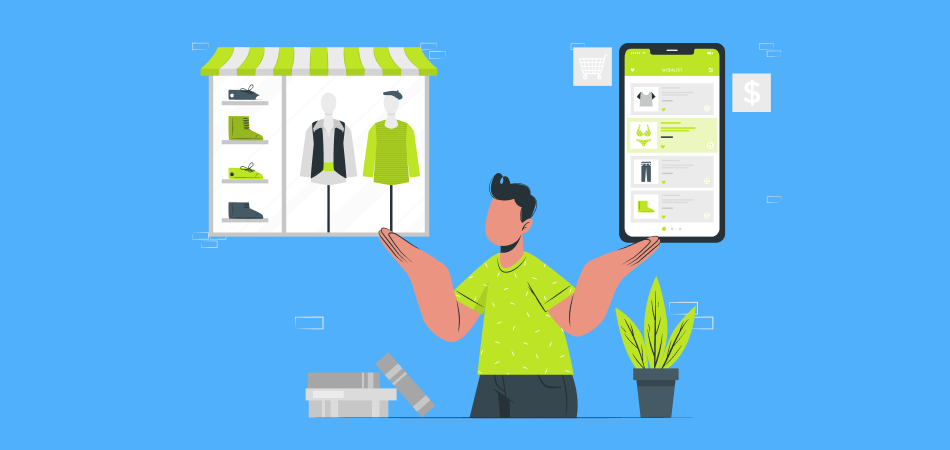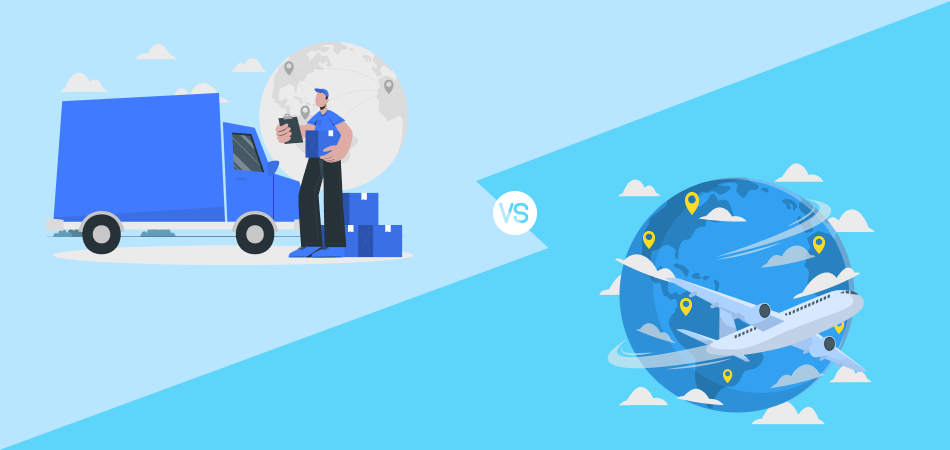Retail vs E-commerce: The Ultimate Guide for Beginners in 2024

In 2024, the retail and e-commerce landscape will continue developing, showing businesses special opportunities and challenges. This guide aims to provide beginners with a comprehensive understanding of the pros and cons of both retail and e-commerce, helping them make informed decisions about which model best suits their business needs.
Retail vs E-commerce: Shopping Experience
Here’s a focused comparison of the speed of transactions for retail vs e-commerce.
E-commerce: Speed of Transactions
Physical Interaction
Sensory Experience: The ability to see the actual size, color, and quality of products enhances decision-making.
Try-Before-You-Buy: Customers can try on clothing, test electronics, and evaluate other items, reducing the likelihood of returns.
Store Atmosphere: The ambiance of a well-designed store can enhance the shopping experience, making it enjoyable and memorable.
Personalized Assistance
Expert Advice: Sales staff can provide professional advice, troubleshoot issues on the spot, and help with complex purchases.
Customization: Personal interactions allow for customized service, whether it’s adjusting a product to fit personal preferences or tailoring a recommendation to suit individual needs.
Customer Relationship: Face-to-face interactions help build strong customer relationships and trust, often resulting in repeat business.
E-commerce: Shopping Experience
Convenience
24/7 Availability: Shopping is available around the clock, accommodating busy schedules and various time zones.
Broad Selection: Online stores often carry a wider range of products than physical stores, including items not sold locally.
Home Delivery: Products are delivered directly to the customer’s doorstep, adding a layer of convenience.
Virtual Experience
Advanced Search and Filter Options: Customers can quickly find products using search tools, filters, and categories, streamlining the shopping process.
Customer Reviews and Ratings: Peer reviews and ratings provide additional insights, helping customers make informed decisions.
Price Comparisons: Easy access to price comparison tools allows customers to find the best deals and promotions, often leading to cost savings.
Retail vs E-commerce: Operational Costs
Here's a detailed comparison of operational costs between retail and e-commerce.
Retail: Operational Costs
Overhead Expenses
Rent and Utilities: Physical stores require significant financial commitments for renting or purchasing retail space. Additionally, utilities such as electricity, water, heating, and cooling add to ongoing costs.
Staffing Costs: Retail stores need a considerable number of employees for various roles, including sales associates, managers, cashiers, and security personnel. This results in substantial payroll expenses, including salaries, benefits, and training.
Maintenance and Upkeep: Regular maintenance, cleaning, and repairs are necessary to keep the store presentable and operational, adding to the cost structure.
Inventory Management
Storage and Display: Retail stores must maintain and manage inventory on-site, which includes the cost of storage facilities and shelving for product display.
Shrinkage and Loss: Physical stores are susceptible to theft, damage, and inventory shrinkage, which can impact profitability.
Seasonal Stock: Retailers often need to adjust inventory based on seasonal demand, which can lead to surplus stock or stockouts, requiring careful inventory management and forecasting.

|
Find Better Supplier For Products DSers Supplier Optimizer - One click to filter out the most proper suppliers for your products |
E-commerce: Operational Costs
Reduced Overheads
No Physical Storefronts: E-commerce businesses do not incur costs related to renting or maintaining physical retail spaces, significantly reducing overhead expenses.
Lower Staffing Needs: While e-commerce requires staff for operations such as customer service, IT support, and marketing, the overall staffing requirements are generally lower than physical retail stores.
Remote Operations: Many e-commerce operations can be run remotely to reduce the need for physical office space and associated costs.
Logistics Management
Shipping and Fulfillment: E-commerce businesses need to invest in efficient shipping and fulfillment processes. This includes warehousing, packaging, shipping, as well as managing returns.
Technology Investment: Robust e-commerce platforms require investment in technology, including website development, maintenance, cybersecurity, and payment processing systems.
Supply Chain Coordination: Effective supply chain management is critical for ensuring timely delivery and inventory availability, often involving sophisticated logistics networks and partnerships with third-party logistics providers.
Retail vs E-commerce: Speed of Transactions
Let's delve into the specifics of the shopping experience for both retail and e-commerce:
Retail: Speed of Transactions
Immediate Gratification
Instant Transactions: Customers can walk into a store, select their desired products, and make an immediate purchase. This instant gratification is a significant advantage of physical retail.
Immediate Product Availability: Products are available for immediate use, which is particularly beneficial for urgent needs or last-minute purchases, such as gifts or perishables.
Checkout Process
Face-to-Face Interaction: The in-store checkout process involves direct interaction with cashiers, which can vary in speed based on factors like the number of customers, efficiency of staff, and payment methods used.
Payment Methods: Physical stores typically accept various payment methods, including cash, credit/debit cards, and mobile payments, providing flexibility for customers.
Potential Delays: Peak shopping times, like holidays and weekends, can lead to long lines and waiting times at the checkout, impacting the overall speed of transactions.
E-commerce: Speed of Transactions
Variable Delivery Times: The speed of e-commerce transactions largely depends on shipping options. While some services offer same-day or next-day delivery, standard shipping can take several days or even weeks, especially for international orders.
Instant Digital Delivery: For digital products such as e-books, software, and online subscriptions, delivery is instantaneous upon payment, providing immediate access to purchased items.

|
Pre-set the Best Shipping Methods DSers Shipping Settings - Pre-select your favorite shipping method to save money and time |
Online Checkout
Streamlined Processes: E-commerce platforms often feature streamlined and user-friendly checkout processes, designed to minimize friction and reduce cart abandonment rates.
Multiple Payment Options: Customers can choose from a variety of payment methods, including credit/debit cards, digital wallets (e.g., PayPal, Apple Pay), and even cryptocurrencies, enhancing convenience.
One-Click Purchasing: Advanced features like one-click purchasing (e.g., Amazon’s "Buy Now" button) further speed up transactions by reducing the steps required to complete a purchase.

|
Adapt Your Product Prices Automatically DSers Automatic Pricing - Pre-set Pricing Rule to mark-up your product price automatically |
Retail vs E-commerce: Customers and Businesses
For customers, retail offers an immersive and immediate shopping experience. It is ideal for those who prefer to see and feel products before buying and for urgent purchases. The social aspect of shopping with friends or family and enjoying in-store events and promotions adds to the appeal.
E-commerce provides unparalleled convenience, a wider selection of products, and often better prices due to lower operational costs. It is suitable for busy individuals, those living in remote areas, and tech-savvy shoppers who value the ease of online transactions. Access to product reviews and detailed information aids informed decision-making.
For businesses, retail offers the advantage of personal customer relationships, brand visibility through physical presence, and immediate sales. However, high operational costs and geographical limitations can be challenging. Retail businesses need to focus on location strategy, customer service excellence, and in-store experience to thrive.
E-commerce allows businesses to scale quickly, reach a global market, and operate with lower overheads. The ability to gather and analyze customer data enhances targeted marketing and personalized offerings. However, competition is intense, and businesses must invest in robust digital infrastructure, cybersecurity, and efficient logistics to succeed.
Retail vs E-commerce: Pros and Cons
In today's commerce landscape, businesses must decide between traditional retail with physical stores and digital e-commerce. Each option has specific benefits and challenges affecting customer experiences, operations, and market reach. Understanding these pros and cons is essential for informed decision-making in 2024 and beyond.
Pros and Cons of Retail
- Personal Customer Interactions: Face-to-face interactions can provide more personalized and immediate customer service. In-person interactions help build strong, loyal customer relationships.
- Immediate Product Availability: Customers can purchase and take home products immediately, catering to urgent needs and reducing the waiting time associated with online orders.
- Tangible Brand Presence: Retail stores can engage with the local community through events, sponsorships, and partnerships, fostering a stronger connection with the brand.
- Opportunities for Impulse Buying: Offering in-store deals and discounts can entice customers to make additional purchases.
- Higher Operational Costs: Running a retail store involves significant fixed costs such as rent, utilities, and salaries for staff.
- Limited Reach to Local Customers: Physical stores are limited to a specific location, restricting their customer base to the surrounding area.
- Inconvenience for Customers Who Prefer Online Shopping: Physical stores may not be accessible to all customers, especially those with disabilities or those living far from the store.
Pros and Cons of E-commerce
- Wider Customer Reach: Online stores are open 24/7, allowing customers to shop at their convenience, which can lead to increased sales.
- Lower Operational Costs: Online stores can easily scale their operations without the need for significant additional investment in physical infrastructure.
- Convenience for Customers: Customers can shop from the comfort of their homes at any time, making the shopping experience more convenient and accessible.
- Access to Data Analytics: Data analytics can help create personalized shopping experiences, such as recommending products based on past purchases or browsing history.
- Lack of Physical Product Interaction: Customers cannot physically see, touch, or try products before purchasing, which can be a significant disadvantage for items like clothing, furniture, or other tactile products.
- Potential Shipping Delays and Costs: Shipping times can vary, and delays can lead to customer dissatisfaction.
- Security Concerns with Online Transactions: Online transactions are susceptible to security breaches, fraud, and hacking, posing risks to customers and businesses.
Conclusion
In 2024, both retail and e-commerce offer unique advantages and challenges. Retail stores excel in personal interactions, immediate product availability, and creating a tangible brand presence but face higher operational costs and limited reach. E-commerce provides wider customer reach, lower operational costs, and greater convenience but lacks physical product interaction and has potential security concerns. By carefully considering these factors, businesses can determine the best strategy to meet their goals and effectively serve their customer base.












 Company
Company
 Why Choose DSers
Why Choose DSers
 Blog
Blog
 Help Center
Help Center




 Live Chat
Live Chat